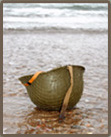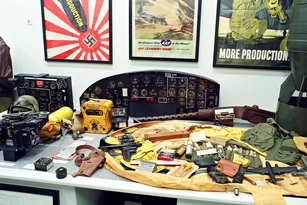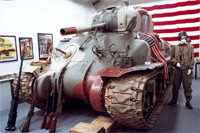 |
The military and industrial might of the United States is reflected in this section of the Museum, as well as the great personalities of the wartime era. The Franklin Roosevelt section includes important wartime manuscripts and artifacts. The weaponry and technology that emerged from this period is shown, and mannequins demonstrate the variety of functions needed to be carried out by the American military. |
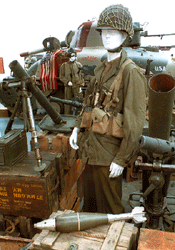 |
|
| |
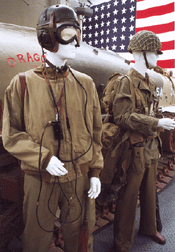 |
The overwhelming ability of the United States to produce war materiel is illustrated by a Sherman tank, originally used in Patton's army in North Africa; a standard issue Jeep, and the air war section which includes two versions of the Norden bombsight. Individual exhibitions of important wartime letters and artifacts of George Patton and Dwight Eisenhower show the important personal side of the war for everyone. |
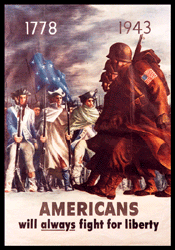 |
|
| |
FRANKLIN DELANO ROOSEVELT |
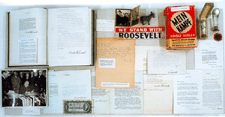 |
FDR artifacts include items from Roosevelt's desk in the Oval Office, his signed transmission to Congress on the Lend-Lease Act, his wartime budget message to Congress, his copy of Mein Kampf, signed wartime Christmas greetings to veterans, and items from the conferences at Teheran and Yalta. |

Bust of Roosevelt, owned by Averill Harriman and sculpted by Jo Davidson. |
|
| |
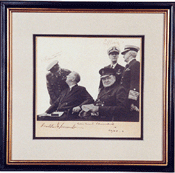 |
Franklin D. Roosevelt and Winston Churchill met for the first time off the coast of Newfoundland in 1941. Their conference resulted in a declaration of common objectives--the Atlantic Charter. |
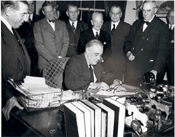 |
This photograph signed by President Roosevelt shows him signing the Declaration of War with Japan. The resolution was passed unanimously by the Senate and with but one vote in the House. |
|
| |
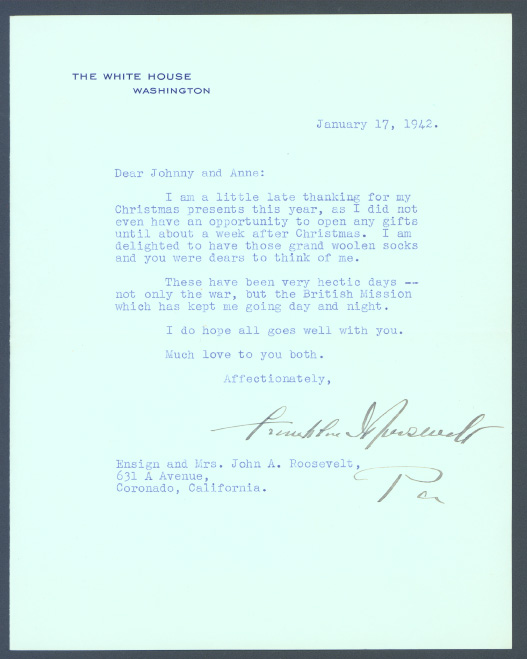 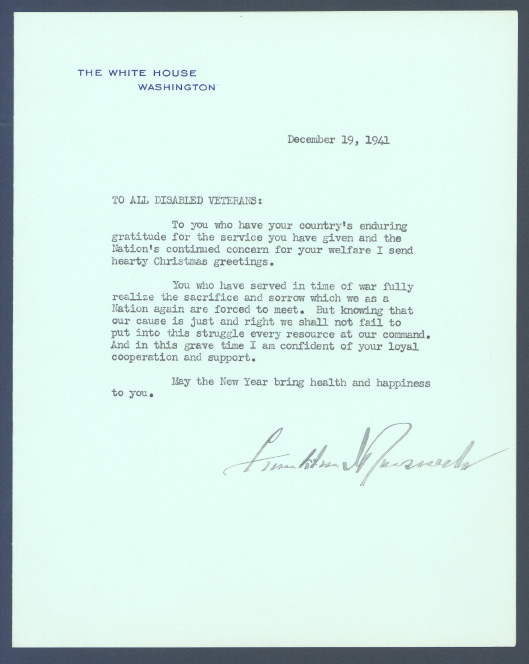 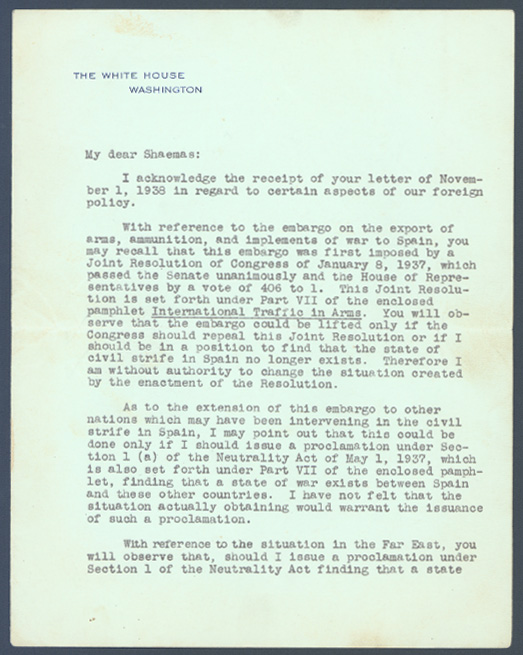 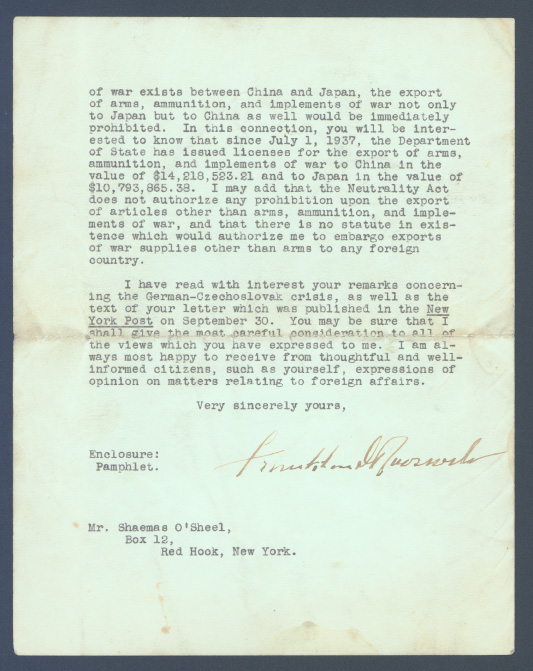 |
| |
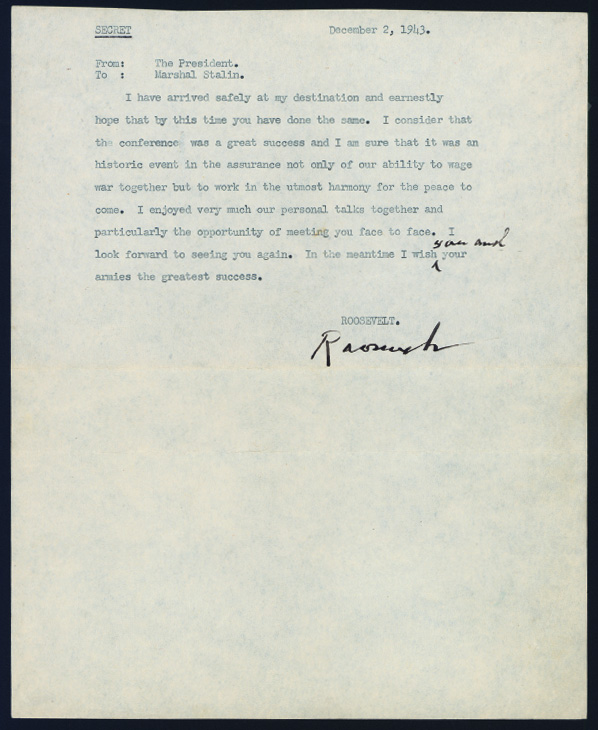
At the Tehran Conference, it was decided that France would be invaded in June, 1944, coinciding with a Russian offensive from the east. |
| |
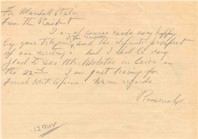 |
Roosevelt to Stalin on Teheran, November 12, 1943: "I am...made very happy by...the definite prospect of our meeting...." President Roosevelt met with Stalin and Churchill in Tehran on November 27. |
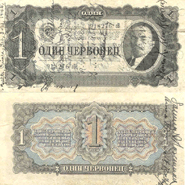 |
This note was signed by Roosevelt and others at the Yalta conference in February, 1945. |
|
| |
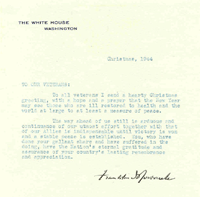
FDR'S CHRISTMAS MESSAGE TO VETERANS, 1944: "To all veterans I send a hearty Christmas greeting, with a hope and a prayer that the New Year may see those who are ill restored to health and the world at least a measure of peace. The way ahead of us still is arduous....You, who have done your gallant share and have suffered in the doing, have the Nation's eternal gratitude and assurance of your country's lasting remembrance and appreciation." |
| |
 |
This poster, garnished with a quote from President Roosevelt, pleads Americans to maximize their efficiency to support the war effort: "Lost ground can always be regained--lost time never!" |
 |
Flag that hung at Franklin Roosevelt's cottage, Campobello Island, 1945. |
|
| |
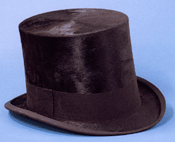 |
Roosevelt's top hat. |
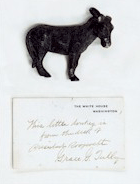 |
A souvenir from FDR's desk: "This little donkey is from the desk of President Roosevelt.--Grace R. Tully". |
|
| |
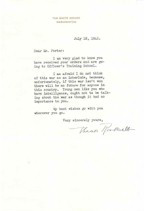 This brief note from Eleanor Roosevelt to a young man enrolling in Officer's Training School, dated July 18, 1942, addressed the importance of winning the war: This brief note from Eleanor Roosevelt to a young man enrolling in Officer's Training School, dated July 18, 1942, addressed the importance of winning the war:
"...if this war isn't won there will be no future for anyone in this country. Young men like you who have intelligence, ought not to be talking about the war as though it had no importance to you." |
| |
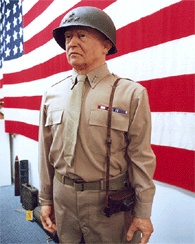
GENERAL GEORGE S. PATTON, JR.
George S. Patton wore this battle helmet throughout World War II. When he was awarded a fourth star at the end of the war, he fastened it to this same helmet he had used as a three-star general. |
| |
 This case displays Patton's personal swords, his swagger stick containing a sword blade, a German SA hat and dagger presented to Patton. The spurs in the upper right hand corner were taken from a Mexican bandit Patton shot; Patton returned to headquarters with the body draped over the hood of his car. This case displays Patton's personal swords, his swagger stick containing a sword blade, a German SA hat and dagger presented to Patton. The spurs in the upper right hand corner were taken from a Mexican bandit Patton shot; Patton returned to headquarters with the body draped over the hood of his car. |
| |
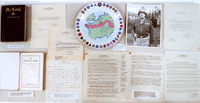 |
Shown here are some of Patton's personal collection of artifacts, including his signed typewritten manuscript of his "Notes on Combat" sent to his former instructor at West Point; his annotated copy of Mein Kampf; a handwritten letter he sent to his mother in 1914; a plate from the dinner service Patton commissioned at the end of the war to commemorate the victories of his armies; and a variety of signed typewritten letters such as his April, 1945 letter to Major General J.P. Smith:
"I may be one of the [finest] generals, but I also have a very fine Army and three splendid Corps Commanders....In fact, if they aren't good, I take their heads off--I do not enjoy this pastime but it is necessary." |
|
| |
 |
Patton's Dress Uniform. |
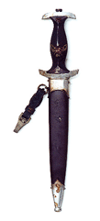 |
German SA dagger presented to Patton. |
|
| |
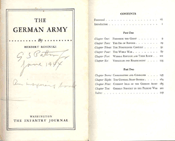
Patton's copy of The German Army read and annotated by him.( "...an inspiring book") in June, 1944, while he waited in England to invade France. |
| |
| A young Patton writes to his father: June, 26, 1904 “I’m very much disheartened by the wonderful efficiency of the modern rifle and there is now talk of them making a gun which fires 20 shots a second. I don’t exactly see how war is to be carried on against such obstacles but if they make a gun which shoots 100 shots a second I would try to learn how to beat them and sill be a great General but when I am, I would burn the man who invented rapid fire guns and by so doing ruined the beauty of war. Still this story of a rapid fire gun may be entirely a myth. I hope it is for if it is war is still feasible and there will be more wars.” |
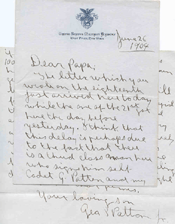 |
|
| |
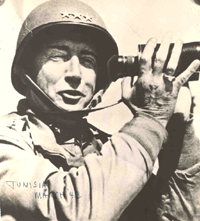 |
IN TUNISIA: A favorite family picture of Patton in March, 1943. |
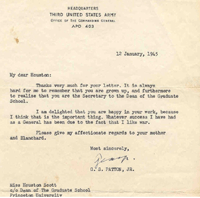 |
LETTER TO A PRINCETON DEAN:
January 12, 1945:
"...It is always hard for me to remember that you are grown up, and furthermore to realize that you are the Secretary to the Dean of the Graduate School. I am delighted that you are happy in your work, because I think that is the important thing. Whatever success I have had as a General has been due to the fact that I like war." |
|
| |
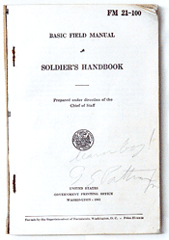 |
This copy of the War Department's Soldier's Handbook--Basic Field Manual has been signed by Patton:
"Learn, boy!"
The book, belonging to a soldier from Buffalo, New York, served as a guide to the life, culture, and discipline of military life, as well as specific instructions on handling equipment and weapons. Largely unchanged from the original December, 1940 edition, this copy included minor changes updated in December, 1942. |
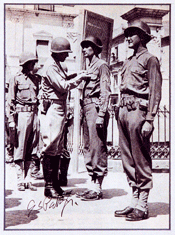 |
Patton, autograph photo, shown decorating soldiers in Italy. |
|
| |
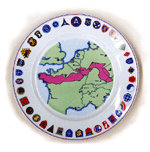 |
Dinner plate commissioned by Patton at the end of the war to commemorate the victories by his armies. |
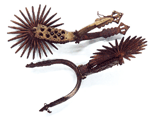 |
Spurs taken by Patton as a trophy from the Mexican bandit Julio Cardenas after Patton's first gunfight.
Cardenas was a key member of Pancho Villa's gang.
Patton and his men strapped the bodies of Cardenas and two other men who had been shot onto the hoods of their cars and returned triumphantly to General Pershing's headquarters. |
|
| |
GENERAL DWIGHT D. EISENHOWER
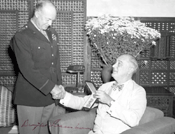 |
This photograph signed by Eisenhower shows President Roosevelt awarding the Legion of Merit to Eisenhower in late 1943.
FDR presented the award during the trip for his conferences with Churchill and Stalin. |
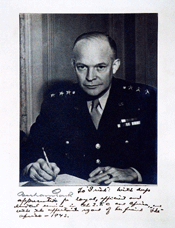 |
Eisenhower to Kay Summersby:
“To ‘Irish’ [Kay Summersby] with deep appreciation for loyal, efficient and devoted service in the E.T.O. and Africa and with affectionate regard of her friend ‘Ike’, Africa 1943.” |
|
| |
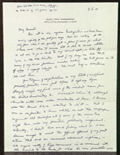
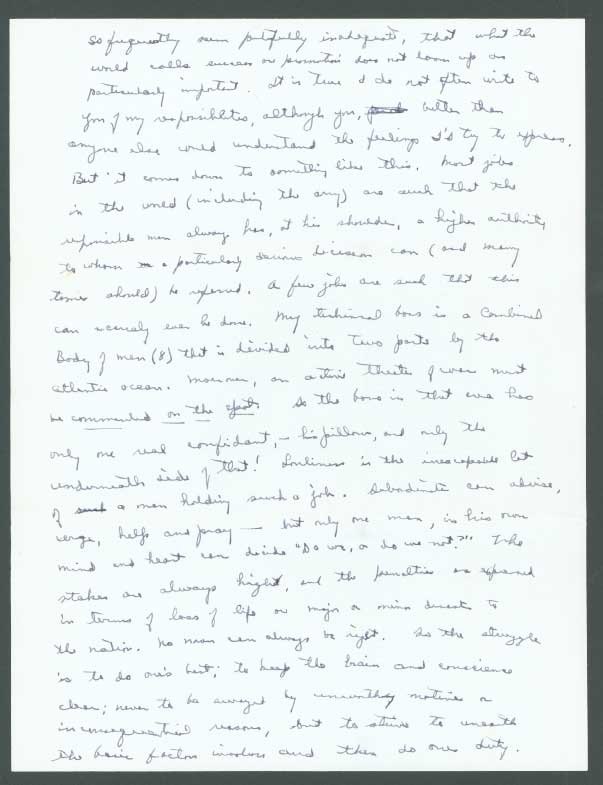 |
Letter from Eisenhower to his wife, Mamie, February 15, 1943. One of the most revealing letters ever written by a Commander in Chief in wartime.
“I am human enough to want the official approval of my past action that such an unusual advancement implies - but anyone worthy of high command is so concerned with the enormity of the tasks, for which his own faculties so frequently seem pitifully inadequate, that what the world calls success or promotion does not loom up as particularly important. I do not often write to you of my responsibilities, it comes down to something like this. Most jobs in the world are such that the responsible man always has, at his shoulders, a higher authority to whom a particularly serious decision can be referred. A few jobs are such that this can scarcely ever be done. My technical boss is a combined body of men (8) that is divided into two parts by the Atlantic Ocean. Moreover, an active theater of war must be commanded on the spot. So the boss in that one has only one real confident - his pillow, and only the underneath side of that! Loneliness is the inescapable lot of a man holding such a job. Subordinates can advise, urge, help and pray - but only one man, in his own mind and heart, can decide “Do we, or do we not?” The stakes are always highest, and the penalties are expressed in terms of loss of life or major or minor disasters to the nation. No man can always be right. So the struggle is to do one’s best; to keep the brain and conscience clear; never to be swayed by unworthy motives or inconsequential reasons, but to strive to unearth the basic factors involved and then do one’s duty.
It is not always easy - in fact the strain comes from not being sure that the analysis has been carefully and accurately made. And when it is clear that the only logical answer is certain to bring criticism; even possible official misunderstanding by superiors; then is when such things as popularity, favorable press, possible promotion, etc. etc., must be completely disregarded - I’m simply trying to say that in a job like this so many things are so big that even a fourth star fails to cause any great internal excitement. I appreciate the confidence of my superiors - and feel damn humble in the face of it, but I do not feel that my major job is finished. I’ve just begun and though the prospect is, in some phases, appalling, I can do my duty only if I steel myself to the requirements and meet them to the best of my ability. When you remember me in your prayers, that’s the special thing I want - always to do my duty to the extreme limit of my ability." |
|
| |
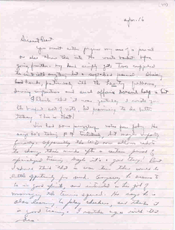 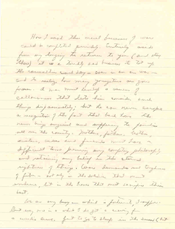 |
Dwight Eisenhower to Mamie, April 16, 1944:
"How I wish this cruel business of war could be completed quickly....It is a terribly sad business to tot up the casualties each day--even in an air war--and to realize how many youngsters are gone forever. A man must develop a veneer of callousness that allows him to consider such things dispassionately; but he can never escape a recognition of the fact that back home the news brings anguish and suffering to families all over the country Mothers, fathers, brothers, sisters, wives and friends must have a difficult time preserving any comforting philosophy and retaining any belief in the eternal righteousness of things. War demands real toughness of fiber--not only in the soldiers that must endure, but in the homes that sacrifice their best." |
|
| |
 |
The museum's 1942 Sherman M42-B1-E9 Tank was in Patton's army in the North African campaign. It was shot up, returned to the U.S. as ballast in a supply ship and converted to a flame thrower with extra wide treads for the invasion of Japan. |
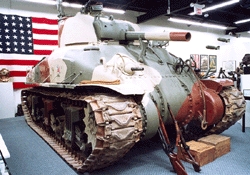 |
|
| |
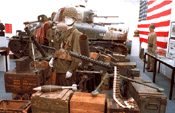
Infantrymen with mortar and shells |
| |
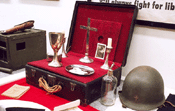 Portable altar used by a military chaplain to hold mass and communion, displayed with a pocket-sized 1942 copy of the New Testament prepared for U.S. Army personnel and a 1943 edition of: A Prayer Book for the Armed Forces and Others in the National Service. Portable altar used by a military chaplain to hold mass and communion, displayed with a pocket-sized 1942 copy of the New Testament prepared for U.S. Army personnel and a 1943 edition of: A Prayer Book for the Armed Forces and Others in the National Service. |
| |
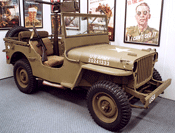 |
A standard issue U.S. Army jeep used during the war. |
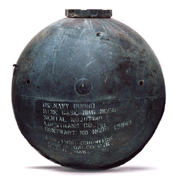 |
U.S. naval mine. |
|
| |
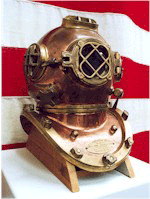 Diving Helmet Diving Helmet |
| |
AIR WAR
|
| |
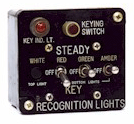 "Friend or Foe" identification light switch from B-29 bomber. "Friend or Foe" identification light switch from B-29 bomber. |
| |
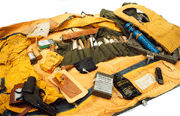 |
Aircraft life raft and equipment, including a drinking water kit, a shark repellant compound pack, life jacket dye marker, and a 1943 edition of Survival on Land and Sea prepared by the U.S. Navy Office of Naval Intelligence. |
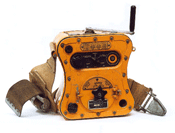 |
“Gibson Girl” radio transmitter for distress signals carried aboard all U.S. bombers. |
|
| |

Norden Bombsight, a mechanical computer that incorporated a gyro-stabilized automatic pilot to aid pilots in precision bombing. Continually refined throughout the war, the complex optical device revolutionized bombing by determining the exact moment bombs needed to be released in order to hit their targets, allowing Allied aircraft to conduct high-altitude bombing runs beyond the reach of defensive artillery. Enormously successful in helping the Allies destroy the Axis Powers' industrial base, the Norden bombsights top secret and closely guarded. It was used to drop the atomic bomb on Nagasaki in August, 1945. |
| |
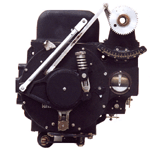 |
Norden bombsight stabilizer (left)
and a Norden trainer (right). |
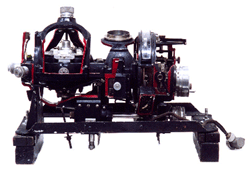 |
|
| |
Equipment used by American G.I.'s
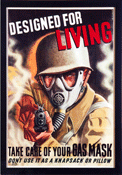 |
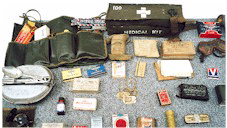 |
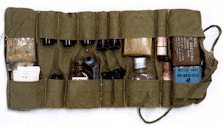 |
Variety of Field Gear,
including 'K' rations
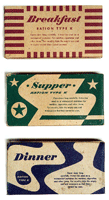 |
|
| |
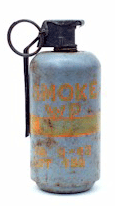 |
Smoke bomb (left)
Artillery training device (right) |
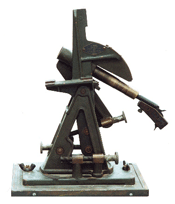 |
|
| |
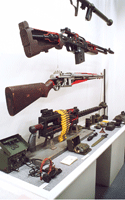 |
Military materiel includes U.S. bazooka; instruction models for the B.A.R., Garand, and .30 caliber machine guns; Navy code practice equipment with headsets and Morse code key; an M2M-209 code machine used by the U.S. for division level and lower message sending; and a U.S. Army trip flare found in Rochrath, Belgium, from the U.S. 2nd Division infantry. |
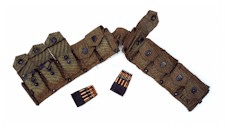 |
Ammunition Belt. |
|
| |
 |
Standard-issue American bayonet |
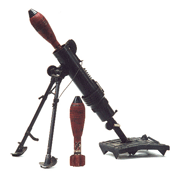 |
Mortar and shell |
|
| |
 |
Collection of machine guns and mortars |
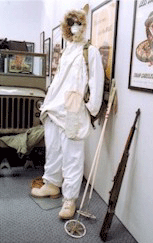 |
Uniform and equipment worn by the 10th Mountain Division |
|






 This brief note from Eleanor Roosevelt to a young man enrolling in Officer's Training School, dated July 18, 1942, addressed the importance of winning the war:
This brief note from Eleanor Roosevelt to a young man enrolling in Officer's Training School, dated July 18, 1942, addressed the importance of winning the war:
 This case displays Patton's personal swords, his swagger stick containing a sword blade, a German SA hat and dagger presented to Patton. The spurs in the upper right hand corner were taken from a Mexican bandit Patton shot; Patton returned to headquarters with the body draped over the hood of his car.
This case displays Patton's personal swords, his swagger stick containing a sword blade, a German SA hat and dagger presented to Patton. The spurs in the upper right hand corner were taken from a Mexican bandit Patton shot; Patton returned to headquarters with the body draped over the hood of his car. 

 Portable altar used by a military chaplain to hold mass and communion, displayed with a pocket-sized 1942 copy of the New Testament prepared for U.S. Army personnel and a 1943 edition of: A Prayer Book for the Armed Forces and Others in the National Service.
Portable altar used by a military chaplain to hold mass and communion, displayed with a pocket-sized 1942 copy of the New Testament prepared for U.S. Army personnel and a 1943 edition of: A Prayer Book for the Armed Forces and Others in the National Service. Diving Helmet
Diving Helmet "Friend or Foe" identification light switch from B-29 bomber.
"Friend or Foe" identification light switch from B-29 bomber.

